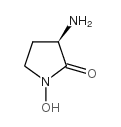(R)-(+)-HA-966

(R)-(+)-HA-966 structure
|
Common Name | (R)-(+)-HA-966 | ||
|---|---|---|---|---|
| CAS Number | 123931-04-4 | Molecular Weight | 116.11900 | |
| Density | 1.436g/cm3 | Boiling Point | 258.6ºC at 760mmHg | |
| Molecular Formula | C4H8N2O2 | Melting Point | N/A | |
| MSDS | USA | Flash Point | 110.2ºC | |
|
Enantiomers of HA-966 (3-amino-1-hydroxypyrrolid-2-one) exhibit distinct central nervous system effects: (+)-HA-966 is a selective glycine/N-methyl-D-aspartate receptor antagonist, but (-)-HA-966 is a potent gamma-butyrolactone-like sedative.
Proc. Natl. Acad. Sci. U. S. A. 87 , 347, (1990) The antagonist effect of (+/-)-3-amino-1-hydroxypyrrolid-2-one (HA-966) at the N-methyl-D-aspartate (NMDA) receptor occurs through a selective interaction with the glycine modulatory site within the receptor complex. When the enantiomers of (+/-)-HA-966 were ... |
|
|
The discriminative stimulus properties of (+)-HA-966, an antagonist at the glycine/N-methyl-D-aspartate receptor.
Eur. J. Pharmacol. 186 , 129, (1990) Using a two-lever operant drug discrimination paradigm, rats have been trained to discriminate between the administration of saline and R-(+)-HA-966 (R-(+)-3-amino-1-hydroxypyrrolid-2-one, 30 mg/kg i.p.) an antagonist at the glycine modulatory site on the N-m... |
|
|
Stereoselectivity for the (R)-enantiomer of HA-966 (1-hydroxy-3-aminopyrrolidone-2) at the glycine site of the N-methyl-D-aspartate receptor complex.
J. Neurochem. 55 , 1346, (1990) HA-966 (1-hydroxy-3-aminopyrrolidone-2) is an antagonist at the glycine allosteric site of the N-methyl-D-aspartate receptor ionophore complex. Unlike presently known glycine antagonists, HA-966 is chiral. We report stereoselectivity for the (R)-enantiomer at... |
|
|
Pharmacological evidence that D-aspartate activates a current distinct from ionotropic glutamate receptor currents in Aplysia californica.
Brain Behav. 2 , 391-401, (2012) D-Aspartate (D-Asp) activates a nonspecific cation current of unknown identity independent of L-glutamate (L-Glu) in neurons of Aplysia californica. Whole-cell voltage clamp studies were conducted using primary cultures of Aplysia buccal S cluster (BSC) neuro... |